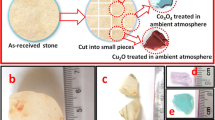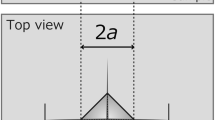Abstract
Chemical reactivity, grindability and zeta potential have been measured and correlated for three variably deformed quartz varieties from three different areas. Results show that there is a strong positive correlation between lattice imperfections and the measured physico-chemical and electrical properties of the three varieties. The highly deformed blue-grey quartz variety records the highest dissolution, grindability and surface electric charges compared to the less deformed milky and rose varieties. Microfabric study supported with XRD results show that the shear-related blue-grey variety exhibits a very strong intracrystalline deformation and high dislocation density indicative of low to intermediate grade conditions. The other two varieties, on the other hand, exhibit deformation features and lower dislocation densities pointing to a much lower grade. The higher chemical reactivity of the blue-grey quartz can be attributed in part to the morphological modifications the shearing creates within the quartz tetrahedra, and to the piezoelectric effect. Such modifications facilitate breaking the Si–O bonds, and lower the activation energy required to initiate the reaction between the silicon ions and the hydroxyl group. Piezoelectricity increases the electric potential across the crystal-liquid interface and hence setting the stage for the chemical reactions. The doubled value of zeta potential of the blue-grey quartz relative to the other two varieties opens the discussion of whether the inherited paleo-piezoelectricity of deformed quartz may enhance and play a significant role in the process of quartz dissolution or not.
Similar content being viewed by others
References
Hassan M, Boulos T (2009) Structural and mineralogical imperfections of some high grade quartz ores diagnose their chemical reactivity. The open mineral J 3:28–31
Wakizaka Y (2005) Alkali–silica reactivity of Japanese rocks. Eng Geol 56:211–221
Abukhadra MR, Shaban M, Mohamed AS, Shahien MG (2019) Characterization and beneficiation of gold mining by-products as source of high-quality silica for high technical applications; response surface studies and optimization. Silicon 11(2):615–625
Dove PM (1994) The dissolution kinetics of quartz in sodium chloride solutions at 25° to 300 °C. Am J Sci 294:665–712
Bickmore BR, Wheeler JC, Bates B, Nagy KL, Eggett DL (2008) Reaction pathways for quartz dissolution determined by statistical and graphical analysis of macroscopic experimental data. Geoch. Cosmoch. Acta 72:4521–4536
Rimstidt JD (2015) Rate equations for sodium catalyzed quartz dissolution. Geochim Cosmochim Acta 167:195–204
Bektas F, Turanli L, Ostertag CP (2006) New approach in mitigating damage caused by alkali-silica reaction. J Mater Sci 41:5760–5763
Brady PV, Walther JV (1990) Kinetics of quartz dissolution at low temperatures. Chem Geol 82:253–264
Nangia S, Garrison BJ (2008) Reaction rates and dissolution mechanisms of quartz as a function of pH. J Phys Chem A 112:2027–2033
Blum AE, Yund RA, Lasaga AC (1990) The effect of dislocation density on the dissolution rate of quartz. Geoch Cosmoch Acta 54:283–297
French WJ (1992) The Characterization of Potentially Reactive Aggregates. Proceedings of the 9th International Conference on alkali aggregate reaction in concrete, p338–346
Brady PV, House WA (1996) Surface-controlled dissolution and growth of minerals. In: Brady PV (ed) Physics and chemistry of mineral surfaces. CRC Press, Florida
Crundwell FK (2013) The dissolution and leaching of minerals mechanisms, myths, and misunderstandings. Hydrometallurgy 139:132–148
Crundwell FK (2014) The mechanism of dissolution of Forsterite, the olivines and the other orthosilicate minerals. Hydrometallurgy 150:68–82
Crundwell FK (2014) The mechanism of dissolution of minerals in acidic and alkaline solutions: part I−a new theory of non-oxidation dissolution. Hydrometallurgy 149:252–264
Crundwell FK (2014) The mechanism of dissolution of minerals in acidic and alkaline solutions: part II−application to silicates. Hydrometallurgy 149:265–275
Crundwell FK (2014) The mechanism of dissolution of minerals in acidic and alkaline solutions: part III−application to oxides and sulfides. Hydrometallurgy 149:71–81
Crundwell FK (2015) The mechanism of dissolution of minerals in acidic and alkaline solutions part IV equilibrium and near equilibrium behaviour. Hydrometallurgy 153:46–57
Crundwell FK (2015) The mechanism of dissolution of the feldspars: part I dissolution at conditions far from equilibrium. Hydrometallurgy 151:151–162
Crundwell FK (2015) The mechanism of dissolution of the feldspars: part II dissolution at conditions close to equilibrium. Hydrometallurgy 151:163–171
Crundwell FK (2016) The mechanism of dissolution of minerals in acidic and alkaline solutions part V surface charge and zeta potential. Hydrometallurgy 161:174–184
Crundwell FK (2016) The mechanism of dissolution of minerals in acidic and alkaline solutions: part VI−a molecular viewpoint. Hydrometallurgy 161:34–44
Crundwell FK (2017) On the mechanism of dissolution of quartz and silica in aqueous solutions. ACS 2:1116–1127
Zoheir B, Emam A, Abdel-Wahed M, Soliman N (2019) Multispectral and radar data for the setting of gold mineralization in the south Eastern Desert, Egypt. Remote Sens 11:1450. https://doi.org/10.3390/rs11121450
Abdel-Khalek ML, Takla MA, Sehim A, Hamimi Z, El-Manawi AW (1992) Geology and tectonic evolution of Wadi Beitan area, southeastern Desert, Egypt. Geology of the Arab World. Cairo, Univ., p. 369–394
Murata KJ, Normanat MB (1976) An index of crystallinity for quartz. Am J Sci 276:1120–1130
Ibrahim SS, Shahien MG, Seliem AQ, Abukhadra MR, Zayed AM (2015) Marwit rod El Leqah quartz deposits as a strategic source of high purity quartz. J Geosci Env Protec 3:41–47
Passchier CW, Trouw RAJ (1998) Microtectonics2nd edn. Springer-Verlag, Berlin, Heidelberg
Passchier CW, Trouw RAJ (2005) Microtectonics2nd edn. Springer-Verlag, Berlin, Heidelberg
Blenkinsop TG (2000) Deformation microstructures and mechanisms in minerals and rocks. Kluwer Academic Publishers, Dordrecht, 150pp
Trouw RAJ, Passchier CW, Wiersma DJ (2010) Atlas of Mylonites and related microstructures. Springer-Verlag, Berlin Heidelberg
Kronenberg AK (1994) Hydrogen speciation and chemical weakening of quartz. In: Heaney PJ, Prewitt CT, Gibbs GV (Eds.), silica: physical behavior, geochemistry, and materials applications. Mineral Soc Am Rev 29:123–176
Luan FC, Paterson MS (1992) Preparation and deformation of synthetic aggregates of quartz. J Geophys Res 97:301–320
Gleason GC, Tullis J (1995) A flow law for dislocation creep of quartz aggregates determined with the molten salt cell. Tectonophysics 247:1–23
Kohlstedt DI, Evans B, Mackwell SJ (1995) Strength of the lithosphere: constraints imposed by laboratory experiments. J Geophys Res 100:17587–17602
Post AD, Tullis J, Yund RA (1996) Effects of chemical environments on dislocation creep of quartzite. J Geophys Res 101:22143–22155
Wintsch RP, Duning J (1985) The effect of dislocation density on the aqueous solubility of quartz and some geologic implications: a theoretical approach. J Geophys Res 90(B5):3649–3657
Gzogyan (2002) Experience of using energy effects in ore preparation and concentration of ferruginous quartzites. J Min Sci 38(2):190–204
Chiara F (1995) Alkali-silica reaction and high performance concrete. Building and fire research laboratory, National Institute of Standards and Technology, Gaithersburg, international report, MD 20899
Acknowledgments
Prof. Basem Zohir is greatly acknowledged for the fruitful discussion and for providing a field photograph of the blue-grey quartz. David A Schiraldi is greatly acknowledged for editorial handling.
Author information
Authors and Affiliations
Corresponding author
Additional information
Publisher’s Note
Springer Nature remains neutral with regard to jurisdictional claims in published maps and institutional affiliations.
Rights and permissions
About this article
Cite this article
Abu Sharib, A.S.A.A., Abukhadra, M.R. Stress-Induced Lattice Imperfections: the Principal Motive in Enhancing some Physico-Chemical and Electrical Properties of some Quartz Varieties. Silicon 13, 653–665 (2021). https://doi.org/10.1007/s12633-020-00458-6
Received:
Accepted:
Published:
Issue Date:
DOI: https://doi.org/10.1007/s12633-020-00458-6




